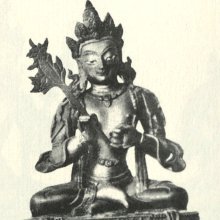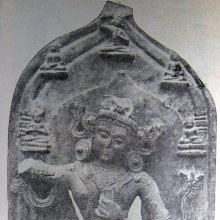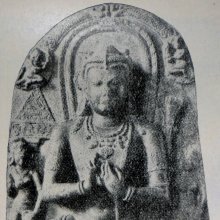Upakeshini, Upakeśinī: 2 definitions
Introduction:
Upakeshini means something in Buddhism, Pali, Hinduism, Sanskrit. If you want to know the exact meaning, history, etymology or English translation of this term then check out the descriptions on this page. Add your comment or reference to a book if you want to contribute to this summary article.
The Sanskrit term Upakeśinī can be transliterated into English as Upakesini or Upakeshini, using the IAST transliteration scheme (?).
Images (photo gallery)
(+4 more images available)
In Buddhism
Tibetan Buddhism (Vajrayana or tantric Buddhism)
Source: archive.org: The Indian Buddhist IconographyUpakeśinī (उपकेशिनी) is the name of a deity sometimes seen accompanying Mañjuśrī, as depicted in Buddhist Iconography.—In his simplest form Mañjuśrī carries the sword in his right hand and the Prajñāpāramitā manuscript in his left. In representations sometimes the two symbols are placed on lotuses. Sometimes Mañjuśrī is accompanied only by Yamāri, sometimes only by his Śakti or female counterpart, sometimes by Sudhanakumāra and Yamāri and sometimes again by the four divinities, Jālinīprabha (also called Sūryaprabha), Candraprabha, Keśinī and Upakeśinī. Though the last four are required to be present with Arapacana, they are nevertheless found in others also.

Tibetan Buddhism includes schools such as Nyingma, Kadampa, Kagyu and Gelug. Their primary canon of literature is divided in two broad categories: The Kangyur, which consists of Buddha’s words, and the Tengyur, which includes commentaries from various sources. Esotericism and tantra techniques (vajrayāna) are collected indepently.
Languages of India and abroad
Sanskrit dictionary
Source: Cologne Digital Sanskrit Dictionaries: Edgerton Buddhist Hybrid Sanskrit DictionaryUpakeśinī (उपकेशिनी).—name of a Buddhist deity or yakṣiṇī, always associated with Keśinī, q.v.: Sādhanamālā 118.18; 120.4; 121.19; 131.18 (all prose). See next.
Sanskrit, also spelled संस्कृतम् (saṃskṛtam), is an ancient language of India commonly seen as the grandmother of the Indo-European language family (even English!). Closely allied with Prakrit and Pali, Sanskrit is more exhaustive in both grammar and terms and has the most extensive collection of literature in the world, greatly surpassing its sister-languages Greek and Latin.
See also (Relevant definitions)
Full-text: Kesini, Five Messengers, Upakeshi, Arapacana, Suryaprabha, Sudhanakumara, Sadyonubhava, Siddhaikavira, Manjushri, Yamari, Jaliniprabha, Candraprabha.
Relevant text
Search found 2 books and stories containing Upakeshini, Upakeśinī, Upakesini; (plurals include: Upakeshinis, Upakeśinīs, Upakesinis). You can also click to the full overview containing English textual excerpts. Below are direct links for the most relevant articles:
The Indian Buddhist Iconography (by Benoytosh Bhattachacharyya)
A Dictionary Of Chinese Buddhist Terms (by William Edward Soothill)





